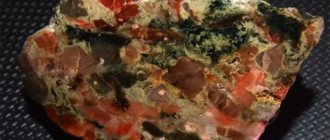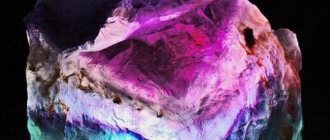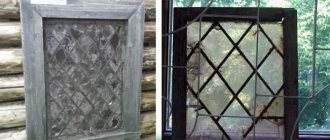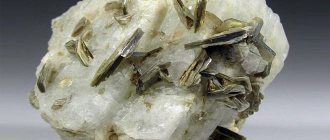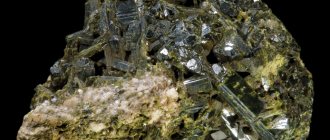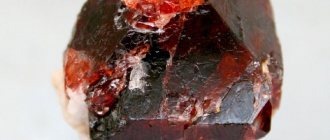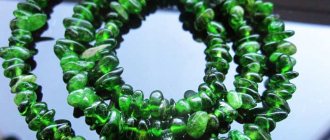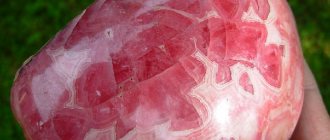Story
Spars were formed as a result of volcanic eruptions, displacement of tectonic plates, exposure to wind and precipitation.
Two-thirds of the volume of the Earth's igneous rocks are minerals of the feldspar group. There are many of them on the Moon and in meteorites. Along with quartz, this is the most common rock on Earth.
The term “feldspars” refers to a group of four dozen minerals.
This is a Swedish-German tracing paper: “spat” is translated from German as a layered, plate-like stone (due to the presence of mica, the crystals are stratified into thin shiny plates); feldt - field, arable land in Swedish, feld - in German.
Used as a scientific term since the 18th century.
Archaeologists find jewelry and household utensils made of feldspars during excavations in Egypt and Asia (at the site of ancient Mesopotamia).
Even the ancient Chinese, who invented porcelain, added spar powder to clay to give strength to dishes, decorative vases and figurines, which made them famous throughout the world.
Mineral composition
Almost all varieties of the mineral are similar in physical properties with the same chemical composition. Representatives of this rock are presented in the form of twin crystals, are distinguished by the presence of mother-of-pearl or glass luster, have an average level of hardness, perfect cleavage and have a distinct iridescent effect.
Man has been mining minerals for many hundreds of years and actively using them in everyday life and industry. From German the name of this group of minerals is translated as “splitting into plates.” The name in this case fully describes the structure and appearance of the rock.
Physico-chemical characteristics
From a chemist's point of view, spar is a silicate.
Feldspars are united in a group by their origin, the presence of aluminosilicate in the composition, the similarity of the crystal lattice and the white color of the trait.
| Formula | { K, Na, Ca, sometimes Ba }{ Al2Si2 or AlSi3 }O8 |
| Color | White to bluish or reddish |
| Stroke color | white |
| Shine | Glass |
| Transparency | Translucent to transparent |
| Hardness | 5—6,5 |
| Cleavage | Perfect |
| Density | 2.54—2.75 g/cm³ |
| singonia | Monoclinic or Triclinic |
| Refractive index | 1,554—1,662 |
The basic formula includes oxides of calcium, sodium, aluminum, and silicon. They can be replaced and supplemented by impurities of chromium, nickel, iron, and copper. As a result, the white crystals take on color.
Varieties of mica
Based on the chemical composition, we can provide the following classification of the mineral in question, namely:
- Magnesian-ferruginous mica – biotite, phlogopite and lepidomelane.
- Aluminum mica – paragonite and muscovite.
- Lithium mica - zinnwaldite, lepidolite and tainiolite.
There is another typology of this mineral, which refers to the concept of “industrial mica”:
- scrap and fine mica (waste parts from the production of sheet mica);
- intumescent mica is vermiculite obtained by firing this mineral;
- leaf mica.
Place of Birth
Feldspars, as rock-forming minerals, form the basis of all continents, including Antarctica. They account for half the mass of the earth's crust.
Raw materials for technical purposes are mined everywhere, unlike jewelry material:
- The most beautiful moon rocks are found in the Pamirs.
- Orthoclase is the heritage of Asia and Europe.
- Germany, India, and China have established industrial production of Labradorite. But the most expensive samples are the pride of Finland.
- India and South America are rich in Amazonites of premium quality. But these are isolated cases: serious production is taking place in the Russian North and in the Baikal region.
The planetary volume of production of technical spar raw materials amounts to billions of tons.
The deposits of Madagascar, Germany, the USA, the Russian Federation, Poland, Ukraine, and Kazakhstan differ in scale.
Where are the stones mined?
Feldspar makes up about 60% of all mineral deposits in the Earth's crust. Basically, it is attributed to igneous origin, not excluding metamorphic formation. Specimens of the breed can be found in every corner of the planet.
Active microcline development is underway in Russia, Poland, Ukraine and some other European countries. Amazonite crystals are overwhelmingly mined in Africa, Brazil and India. China, Canada, Germany and Greenland are rich in Labrador. Particularly valuable samples are found in Finland. Active mining of orthoclase is carried out in Russia, Mexico, Australia, Italy and some other countries, and adularia predominates in Tajikistan, India, Switzerland, Sri Lanka and some states of America.
Colors and varieties
Mineralogists distinguish the following varieties of feldspars:
- Potassium feldspars. Calcium in the composition is replaced by potassium. Typical representatives are adularia, orthoclase, sanidine, microclines (including amazonite). Orthoclase is translucent, sometimes completely transparent, painted in gray-pastel colors.
Orthoclase - Calcium. Spars with inclusions of calcite, sodium appears in the crystal lattice. Also known as plagioclases. Jewelry types – labradorite, andesine, heliolite, albite (rare). They are distinguished by their bright colors and iridescent surface (especially Labradorite). Graphic pegmatite is coveted by collectors.
Labrador - Potassium-barium feldspars . The most famous is Celsian. This green or greenish-brown stone is very rare, found as inclusions in metamorphic rock. However, it is opaque, so it is sought after only by collectors, but not by jewelers.
Their abundance determines the presence of almost all colors in the minerals of the feldspar group: from bluish-black labradorite to golden heliolite.
Deposits and production
Due to its prevalence, the stone is found throughout the world. It is often mined on an industrial scale. Large deposits are located in the following countries:
- Russia;
- Norway;
- USA;
- Canada;
- Japan;
- Armenia;
- Germany.
You should know that this mineral is mined mainly by hand. In the largest deposits, reserves exceed 12 million tons.
Where are feldspars used?
Depending on their appearance and condition, feldspars are sorted by industrialists, jewelers and collectors.
Industry
Opaque, nondescript stones have found application as industrial raw materials:
- This is a source material for the production of glass, ceramics, and building materials.
- The production of electrical products (cables, insulators) and plumbing equipment cannot be done without spar.
- Composite materials based on feldspars are used in all areas of mechanical engineering, including defense, space and high technology.
- The mineral is used in welding, metallurgy, and construction (ore, mineral paints, rubber, cladding).
Feldspar is used to make light abrasives for cosmetics and perfumes (toothpaste, scrubs, soap).
Jewelry
Jewelers are in demand for translucent and transparent varieties: adularia, amazonite, andesine, heliolite (or sunstone), labradorite.
Amazonites
They are used to make original jewelry or used as an imitation of more expensive stones.
Who is suitable according to their zodiac sign?
For each zodiac sign you can choose your own feldspar amulet. To put it simply, the mineral is considered universal for any person, since the stone in astrology is considered universal. Regardless of this, it is important to know which signs are best suited for feldspar and which are not.
Compatibility of feldspar with zodiac signs (“+” - ideal, “±” - allowed to be worn, “-” - contraindicated).
| Zodiac sign | Compatibility |
| Aries ♈ | + |
| Taurus ♉ | ± |
| Gemini ♊ | — |
| Cancer ♋ | ± |
| Leo ♌ | ± |
| Virgo ♍ | ± |
| Libra ♎ | ± |
| Scorpio ♏ | + |
| Sagittarius ♐ | ± |
| Capricorn ♑ | ± |
| Aquarius ♒ | — |
| Pisces ♓ | ± |
How to spot a fake
Almost all spars are inexpensive, they are rare, but they are counterfeited:
- More often they use glass with copper particles (it becomes similar to heliolite). Interspersed with chrome or nickel imitate labradorite.
- However, the iridescence is not so bright, and the shine when turning is uneven, the imitation looks poorer in color.
- To identify a sample, you hold it in your hands - the stone will not heat up immediately and will be massive. Light will refract in a vessel with water.
Any spar can easily scratch glass.
It is only possible to accurately determine the origin of a sample using special equipment, so it is better to buy jewelry from trusted sellers.
How to care
Feldspars do not require special care:
- An ordinary box is enough for storage.
- Dirt is removed with warm water and a light detergent.
- Dry with a paper towel or soft cloth.
Once every six months, you can do a general cleaning in a solution of water, detergent and ammonia - proportion 200:30:20 ml. The products are left for 10–15 minutes, after which they are rinsed with clean water and dried with a napkin.
Small plastic made of mineral requires care. You need to place it so that it doesn’t fall and no one hits it.
Price
Industrial spar raw materials are sold on the world market at $85–105 per ton. They charge even more for sanidine, an essential component of elite “bone” china.
Russian stores offer to buy jewelry and collectibles from all over the world (price/rub.):
- heliolite (bead, diameter 2 mm) – 92;
- amazonite (30x45x43 mm, India) – 1,800;
- sanidine (36x13x18 mm; Madagascar) – 820;
- microcline (43x25x41 mm, Kola Peninsula) – 200.
The most expensive of jewelry spars is heliolite. Prices for jewelry with such inserts are thousands (silver) or tens of thousands (gold) rubles.
Medicinal properties
The healing properties of feldspars have been thoroughly studied:
- Andesine neutralizes depression or suicidal tendencies.
- Amazonite improves the functioning of the heart and the state of the central nervous system.
- Heliolite is beneficial for blood and skin.
- Labradorite normalizes the functioning of the musculoskeletal system and restores reproductive functions.
- Adularia and orthoclase relieve attacks of epilepsy, inhibit oncology, and relieve depression.
Only natural and whole specimens are suitable for medicinal or magical purposes.
Stone compatibility
Each variety of feldspar has a friendly mineral with which it is most compatible. There are other mineral combinations where feldspar exhibits a neutral relationship to another gem.
Excellent compatibility with adularia is observed in:
- onyx;
- lapis lazuli;
- pearls;
- amethyst;
- sapphire;
- coral
Cannot be combined with malachite, jasper, garnet and agate.
Ideal for Labrador:
- beryl;
- rose quartz;
- aquamarine;
- topaz;
- opal;
- amethyst;
- nephritis.
It is not recommended to combine with ruby, diamond, carnelian, garnet, and jasper.
Feldspar in nature
For Amazonite, the following are considered positive stones:
- jasper;
- rhinestone;
- rauchtopaz;
- fire opal;
- aquamarine.
It is forbidden to wear amozonite with agate, black and white sardonyx, morion, and onyx.
These minerals have excellent compatibility with each other, complementing and enhancing each other’s qualities.
Magic properties
The magical properties of feldspar group minerals are determined by the type of stone:
- Labrador. Used by esoteric practitioners to develop paranormal abilities, communicate with otherworldly forces, or travel through time. At the everyday level, it replenishes the body’s reserves, helps develop intuition and a thirst for knowledge. However, the stone “loves” older people more.
Ring with labradorite - Adularia, orthoclase. Needed to achieve or maintain a home microclimate, love.
Orthoclase 10.34 carats
By changing its color, orthoclase warns of adultery or impending unfavorable changes.
- Amazonite It is important as a talisman of family ties. It also inspires self-confidence, makes you bolder and more assertive. But caution is needed: a person can become rude or rowdy.
Amazonite bracelet - Moon rock – an attribute of creative people and public figures. It will help you concentrate, express your thoughts clearly, and maximize your talents. Or become a psychic.
Moon rock
All spars protect a person from envy, damage, and other manifestations of dark energy.
